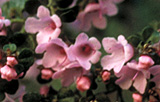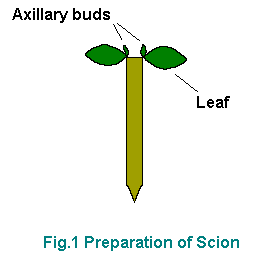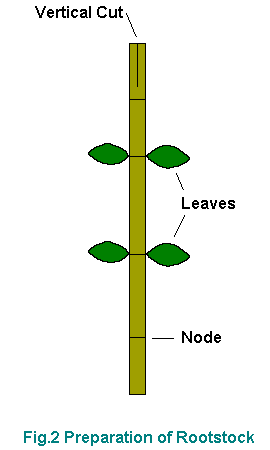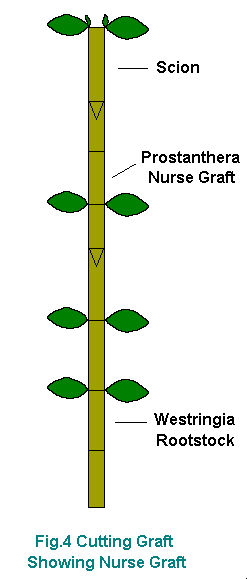|
[Front Page] [Features] [Departments] [SGAP Home Page] [Subscribe]

Grafting Prostantheras
Robert Miller
Editors note...The genus Prostanthera comprises about 60 -70 species in the plant family Lamiaceae. All are Australian endemics. They are related to the common aromatic herbs such as mint, thyme and sage and are, in fact, called "Mint Bushes" because the foliage of many species contain aromatic oils and emit a pleasant aroma when crushed or brushed against. In the Australian bush the aroma of mint bushes can be very pronounced following rain.

Prostanthera rotundifolia is one of the most popular members of the "Mint Bushes" in Australian gardens. Flowers are usually purple but many other colours are found including this attractive pink form. Select the thumbnail image or plant name for a higher resolution image (21k).
Despite their popularity, Mint Bushes are very susceptible to the root pathogen Phytophthora cinnamomi and, in some areas, can be short lived. In recent years grafting has been used to improve the hardiness of this very colourful group of plants. The plant Westringia fruticosa, referred to in the following article, is closely related to Prostanthera and, as it is very hardy under most garden conditions, has received a lot of attention as a rootstock.
The most important thing to remember about grafting is, it's easy.
I can hear some of you saying, "It is, if you know how!" or "..., if you've got the touch!". Well the answer is, it truly is easy, if a little attention to detail and the right after care is provided.
 There are many types of grafts, some simple and others which appear to be contrived to baffle the layman and torture the would-be horticulture student. Hence most people, amateur and professional alike, have "put off" grafting for life! In my opinion, difficult acts of carpentry have little place in grafting Prostanthera. I see no advantage in mastering such techniques, especially for use on thin diameter material, as the claims of superior strength or better cambial contact have little or no merit in such instances. I do not believe that a graft that is only 0.5-2 cm long and from 2-5 mm in diameter can have greater strength depending upon the grafting technique used, especially once the plant has reached maturity. More importantly, it is the compatibility of the rootstock with the scion and the selection of the wood (stage of growth) of both the scion material and the rootstock which is important. The two rootstocks I use most frequently are Prostanthera nivea (Eugowra form) and Westringia fruticosa. These two rootstocks will give good success in most soil types, however other species may give as good or possibly superior success in your conditions. Try using as a rootstock the most reliable Westringia or Prostanthera in your area.
There are many types of grafts, some simple and others which appear to be contrived to baffle the layman and torture the would-be horticulture student. Hence most people, amateur and professional alike, have "put off" grafting for life! In my opinion, difficult acts of carpentry have little place in grafting Prostanthera. I see no advantage in mastering such techniques, especially for use on thin diameter material, as the claims of superior strength or better cambial contact have little or no merit in such instances. I do not believe that a graft that is only 0.5-2 cm long and from 2-5 mm in diameter can have greater strength depending upon the grafting technique used, especially once the plant has reached maturity. More importantly, it is the compatibility of the rootstock with the scion and the selection of the wood (stage of growth) of both the scion material and the rootstock which is important. The two rootstocks I use most frequently are Prostanthera nivea (Eugowra form) and Westringia fruticosa. These two rootstocks will give good success in most soil types, however other species may give as good or possibly superior success in your conditions. Try using as a rootstock the most reliable Westringia or Prostanthera in your area.
My preferred technique is the cutting graft (Fig 2), where both the scion (Fig.1) and the rootstock cutting are done simultaneously using the top wedge graft (Fig 3). I have developed this technique as it is relatively quick, easy and takes up little room. Admittedly, it may often be more successful grafting onto struck rootstock, however this often requires timing (ensuring the plants are at the same growth phase) and more room to often achieve the same results. The cutting graft technique eliminates the need for having a supply of struck rootstock on hand and is very useful for the unexpected arrival of material.
  With difficult species it is normally easier and more successful to try grafting than to put in cuttings with limited material. I back both "horses in the race" if sufficient material is available.
With difficult species it is normally easier and more successful to try grafting than to put in cuttings with limited material. I back both "horses in the race" if sufficient material is available.
The Grafting Details
Ideally, the right wood for the scion is vigorous, healthy soft-wood material that is not in flower (this is not often possible from the wild, especially when collecting colour forms) which has dormant or very small axillary shoots. This is prepared as one would prepare a cutting. Normally, with larger leafed species, only one set of leaves are left on the scion but with smaller sclerophyllous species more leaves may be able to be left on depending on the condition of the scion material.
 The rootstock should be semi-hardwood at the base and firm softwood at top (without signs of pith in the centre of the branchlet). This is often obtained by using vigorous shoots (eg· after hard pruning). Removing the appropriate amount off the soft tip (normally 1-4 nodes from the tip) will give a firm point, but still one that has not developed pith, to do your vertical cut. I try to achieve a rootstock cutting that has two nodal points at the top with the leaves removed, then two nodal points with leaves left on and then two nodal points with leaves removed at the bottom (Fig 2). It is advantageous if the rootstock and the scion are of the same diameter as this reduces the need to match cambial tissue. Your success will be further enhanced if the nodal portions of both the scion and the rootstock are aligned, as a thicker band of cambial tissue occurs in this region and, in theory, this should result in greater success. This is a simple procedure if the cuts are made in the appropriate positions (Fig 3).
The rootstock should be semi-hardwood at the base and firm softwood at top (without signs of pith in the centre of the branchlet). This is often obtained by using vigorous shoots (eg· after hard pruning). Removing the appropriate amount off the soft tip (normally 1-4 nodes from the tip) will give a firm point, but still one that has not developed pith, to do your vertical cut. I try to achieve a rootstock cutting that has two nodal points at the top with the leaves removed, then two nodal points with leaves left on and then two nodal points with leaves removed at the bottom (Fig 2). It is advantageous if the rootstock and the scion are of the same diameter as this reduces the need to match cambial tissue. Your success will be further enhanced if the nodal portions of both the scion and the rootstock are aligned, as a thicker band of cambial tissue occurs in this region and, in theory, this should result in greater success. This is a simple procedure if the cuts are made in the appropriate positions (Fig 3).
Not all species of Prostanthera will graft successfully onto Westringia fruticosa but most will graft onto P. nivea. The National Botanic Gardens (Canberra) developed a nurse graft technique for such species which I have modified slightly for use as a cutting graft (Fig 4). This involves grafting P.nivea onto Westringia and then the desired Prostanthera on top of the P. nivea. This technique can be done at separate stages or all as one operation.
Equipment
I will be adamant about this aspect. Although I have used with success everything from plumbers' tape, horticultural grafting tape, budding knifes and bitumen based sealants, I now would only use these things as a last resort. I could go into the pros and cons, BUT if you want reliable results use the following ONLY!.....new scalpel blades, Nescofilm (for use as grafting tape, see footnote), sharp sterile fine pointed secateurs or bonsai scissors and an atomiser to mist plant material and finished grafts to prevent them from drying out.
Suggested order of operation
A production line approach in my experience gives the best results.
- Prepare work place, cutting mix into pots, cutting box, fill atomiser with clean water, sharpen and clean secateurs, cut nescofilm into appropriate width strips.
- Obtain rootstock and scion material (labelling each species) keeping it moist and cool at all times. Layers of dampened newspaper and plant material in a cardboard box works extremely well, with evaporation keeping the cuttings cool.
- Prepare all rootstocks, sorting them according to their diameter.
- Prepare all scion material and sort them according to their diameter.
- Graft each species as a batch assuring labelling is correct.
- Apply rooting hormone to rootstock ensuring a fresh cut is executed immediately below a node.
- Place grafts into propagation mix and then into the propagation area. I prefer to place the cuttings around the sides of the tubes. This appears to give superior strike rate and the size of the pot allows for easy handling.
- After care - ensure that the cutting mix does not become waterlogged or too dry. Mist grafts as required; this will depend on your conditions and time of the year. You should mist them at least once a day for the first week or so.
Note: "Nescofilm" is a thin clear plastic tape used in the pharmaceutical industry. It is usually only available in very long lengths of around 30 meters...enough for several lifetimes of grafting! Usually several keen plant propagators pool their resources to purchase a roll of the tape. Although not adhesive, the tape tends to stretch and adhere to itself making the tying of tape around thin plant material unnecessary. A similar product is "Parafilm".
Robert Miller is the leader of the SGAP's Prostanthera and Westringia Study Group. He is a keen grower and collector of Australian plants. This article has been reproduced from "Lasianthos" Number 1 (1993), a special publication of the Study Group.
 [Front Page] [Features] [Departments] [SGAP Home Page] [Subscribe]
[Front Page] [Features] [Departments] [SGAP Home Page] [Subscribe]
The Society for Growing Australian Plants
|